 |
||
|
||
| ||
 Once upon a time NVIDIA was just a little nice Cinderella, and it didn't have a cent to its name and wasn't held in respect. There were other giants - ATI Technologies and Matrox Graphics, the old Canadian companies, which had enough experience in production of video cards and chipsets by that time. Another company playing in this sector was 3dfx... NVIDIA, however, was a healthy baby and was growing very fast. ATI and Matrox, engaged in their mutual competition, didn't pay attention to the baby. However, NVIDIA kept growing and soon turned into a Monster, or rather a Queen on the market of 3D accelerators. Matrox now keeps its position only in a narrow sector of professional 2D graphics... ATI, having realized that it had been outscored, tried to catch up with NVIDIA, looking for outside programmers for patching up its worn-out software. But I should say that the company didn't lose its authority thanks to high-quality 2D graphics and normal support of MPEG2/4. Recently it provided two-monitor support as well. As to 3dfx, it couldn't stand the race and passed on. NVIDIA the Queen acquired a great deal of Asian card makers. However, it soon got a swelled head (what company which is almost a monopolist wouldn't be a dictator?). The result was $400 accelerators with no alternatives... But the former queen had no desire to give up. It got a new weapon to withstand the competition, and our ATI RADEON 8500 review is the direct evidence of it. The new fighter proved to be a good competitor against the GeForce3! That is why the American company gave out a series of different modifications of GeForce3 which was lacking in the roadmaps before. The GeForce3 Ti 500 was, thus, the most powerful 3D accelerator of the High-End level which outperformed the Canadian processor in some tests. In response ATI cut the price of its warrior putting it on the level of GeForce3 Ti 200, though it had much better functions and performance. It is no secret that NVIDIA will "punish" those firms which will dare produce cards from its competitor. It is no matter how, but it is clear that they all are really afraid of the Queen. However, there is always a way-out. And this time it is a registration of subsidiaries for production of video cards, for example, from ATI or STM/PowerVR. At the same time, the reason of foundation of such company is kept back, though everybody understands that a newly born company can't make products in an expensive Retail package of the high quality... I think the manufacturer of the card we consider today is definitely backed up... But let's stop discussing the marketing stuff and return to the technical issues. Like the GeForce 3 the RADEON 7500/8500 will be examined for a long time with detailed investigations of its possibilities and functions. Theoretical materials and reviews of video cards which concern functional properties of the GPU ATI RADEON 8500/7500 CardsPowerMagic RADEON 8500The PowerMagic RADEON 8500 card has an AGP x2/x4 interface, 64 MBytes DDR SDRAM located in 8 chips on the right and back sides of the PCB. 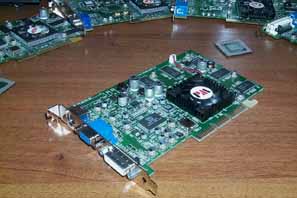 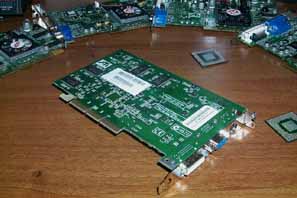 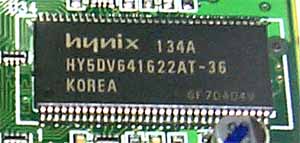 Hynix produces memory chips with 3.6 ns access time which corresponds to 277 (554) MHz. As you can see, the memory is identical to the one we saw in the ATI RADEON 8500 review. But both the chip and the memory work at 250/250 (500) MHz. It means that we, in fact, have RADEON 8500 LE which was recently announced by ATI. However, the developer doesn't indicate that it is the underclocked RADEON. It is a card which not just follows the reference sample, but it is a card "from ATI", i.e. THE SAME: PowerMagic RADEON 8500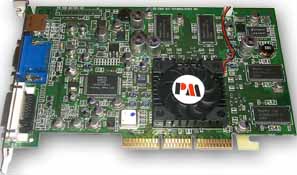 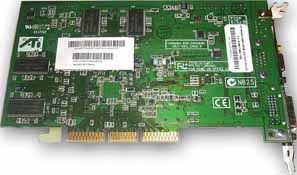 The only slight difference is a sticker on the cooler which has PM letters. On the back side there is even a sticker with the series number from ATI. And a new sticker from PowerMagic. The PowerMagic RADEON 8500 has VGA, DVI and TV-out. (We have already written about this.) 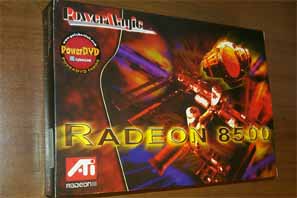 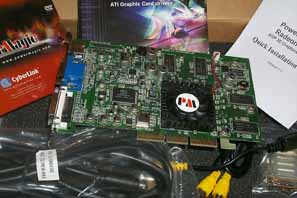 The card ships in a Retail package. Accessories:
OverclockingOn one hand, the memory is the same as in the card operating at 275 MHz (which reached 300 (600) MHz), and the memory controller allows changing its frequency regardless of the chip speed, but it was impossible to overclock the memory higher than 280 (560) MHz. And even at this frequency we had artefacts that is why the tests were carried out at 275 (550) MHz. It is interesting that the GPU has a weak overclocking potential as well. On the whole, the overclocking resulted only in 275/275 (550) MHz. Maybe it is done purposely (in the BIOS) so that overclocked cards from partners don't hamper sales of Retail versions from ATI. Note:
PowerMagic RADEON 7500The PowerMagic RADEON 7500 card has an AGP x2/x4 interface, 64 MBytes DDR SDRAM located in 8 chips on the right and back sides of the PCB. 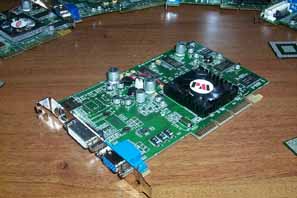 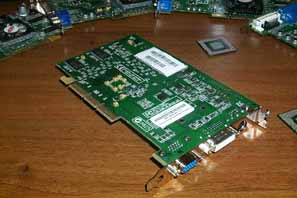 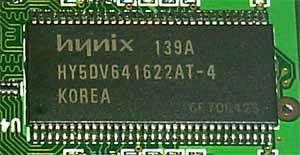 Hynix produces memory chips with 4 ns access time which corresponds to 250 (500) MHz. The memory works at the frequency rated for RADEON 7500 - 230 (460) MHz. The chip's clock speed is decreased to 270 MHz (the ATI's card had a chip working at 290 MHz). We can see again that the partners have chips working at a lower frequency than those of ATI. But there is difference between the RADEON 8500 and RADEON 7500. ATI announced an underclocked chipset but nobody heard about the RADEON 7500 LE. Users were angry with the fact that the company sold expensive underclocked cards. However, ATI managed to establish order in this sphere. That is why the today's card doesn't differ from the one we got from ATI: PowerMagic RADEON 7500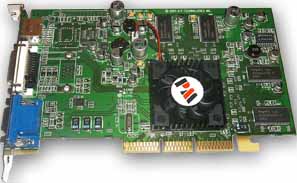 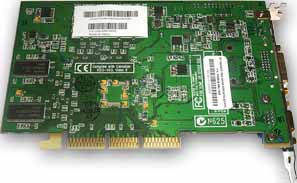 As you can see, the difference is only in PM letters on the cooler. 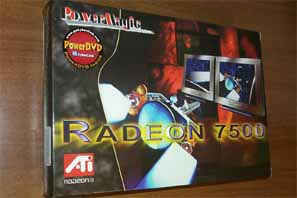 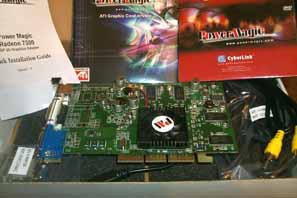 The card ships in a Retail package. Accessories:
OverclockingThe PowerMagic RADEON 7500 showed an excellent overclocking potential of the core (360 MHz!) and a good one of the memory - 260 (520) MHz. Note:
Installation and driversTest system:
During the tests we used ATI drivers of v7.189, v7.191 and v7.206, VSync was off, the S3TC technology was enabled. The cards come with the ATI's drivers of ver.7.189. For the comparative analyses we used the following cards:
Test resultsI has no complains about 2D quality, especially considering that they are in fact ATI's cards. The 1600X1200@85 Hz mode is comfortable for operation. The dual-monitor support was considered earlier. DVD playback is going to be examined closer. As the ATI's DVD player works unstably quite often and the PowerDVD 3.0 player (CyberLink) still doesn't recognize the RADEON 8500 we carried out the tests with the WinDVD 3.0 (InterVideo). First of all, let's take a look at the quality: Example 1PowerMagic RADEON 8500 PowerMagic RADEON 7500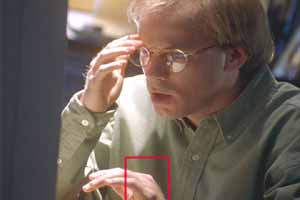 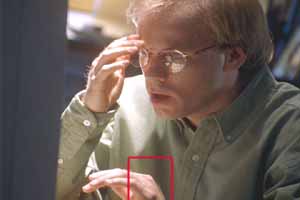 GeForce3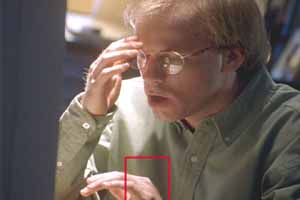    Example 2PowerMagic RADEON 8500 PowerMagic RADEON 7500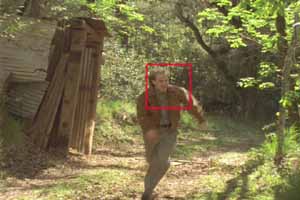 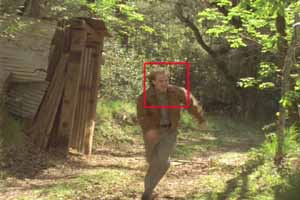 GeForce3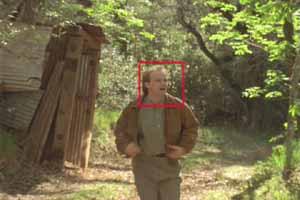    Example 3PowerMagic RADEON 8500 PowerMagic RADEON 7500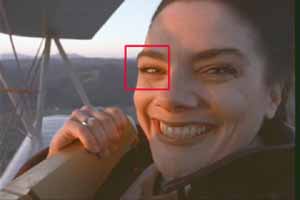 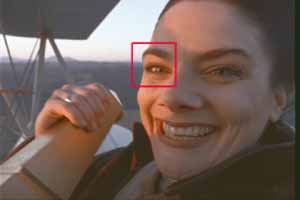 GeForce3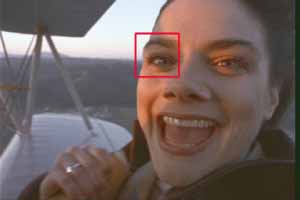 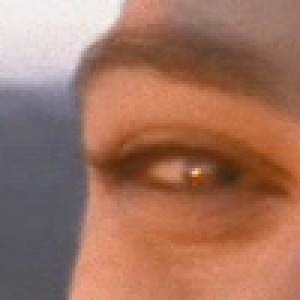 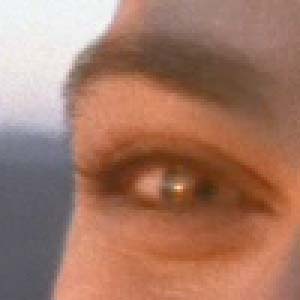 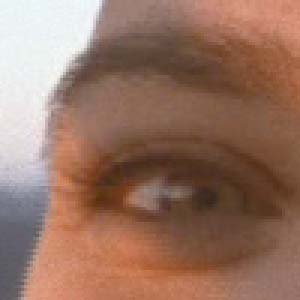 It is clear that the RADEON 7500 and 8500 have equal quality. Look at the shot of the GeForce3; the RADEON 8500 has no such artefacts which means a better deinterlacing method. Now comes the CPU utilization: PowerMagic RADEON 8500 PowerMagic RADEON 7500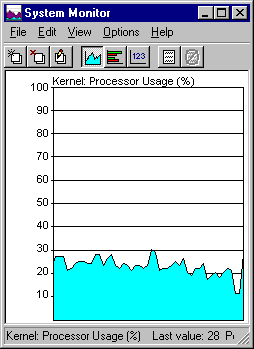 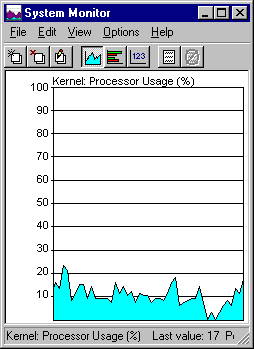 GeForce3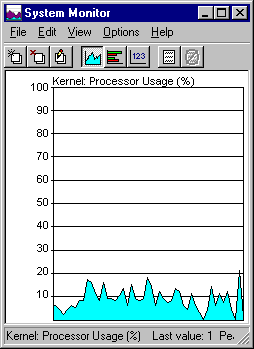 It is possible that the WinDVD 3.0 is not yet able to operate correctly with the 8500 chipset, or it may be that the drivers are poor. For estimation of 3D quality we used:
In this section we will consider the performance of the cards and operation of the new drivers from ATI of v7.206 with the SmoothVision support (it is a new technology from ATI demonstrating a new kind of anti-aliasing). We will also collate driver versions (7.189 (official), 7.191 (beta, recommended for the RADEON 8500), 7.199 (beta) and 7.206 (newly released beta)). I must note that in the last version ATI corrected the unfair optimization of operation of the RADEON 8500 in the Quake3 when the performance grew up at the expense of quality. Operation of the RADEON 7500 won't be examined in detail; we will only compare it with other cards of this class. PowerMagic RADEON 7500Quake3 Arenademo002, standard modesThe tests were carried out in the Fast mode (16-bit color) and High Quality mode (32-bit color). 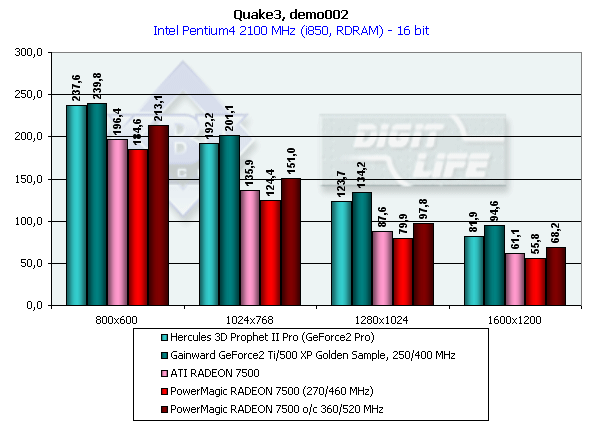 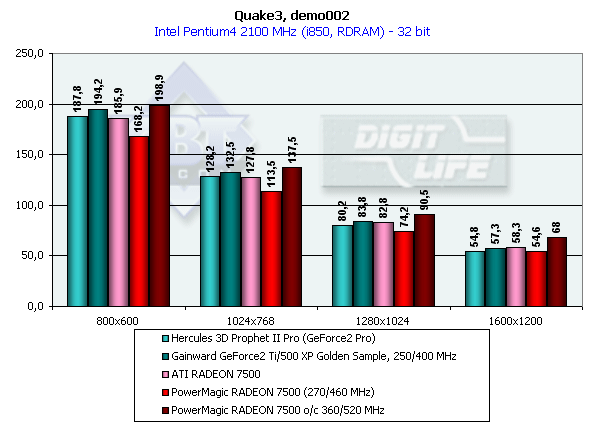 In 16-bit color it loses to the contestants, while in 32-bit one it goes up. The decrease in frequency from 290 to 270 MHz of the ATI RADEON 7500 resulted in a poor performance, and even in a 32-bit color the NVIDIA GeForce2 Pro/Ti takes a sure lead. quaver, Highest quality modeThe tests were carried out in 16 and 32bit color modes with the maximum detailing level of textures and geometry (r_lodCurveError "30000" r_subdivisions "1"). 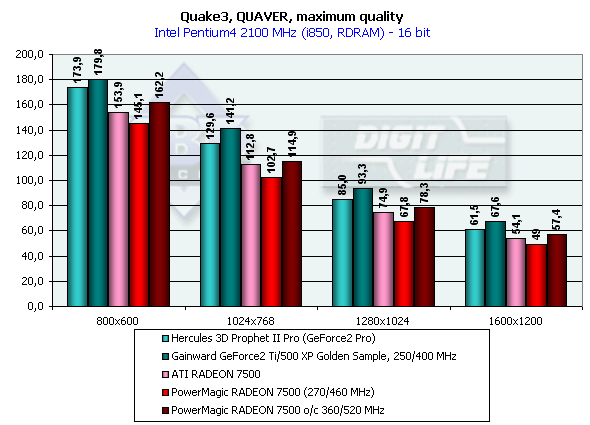 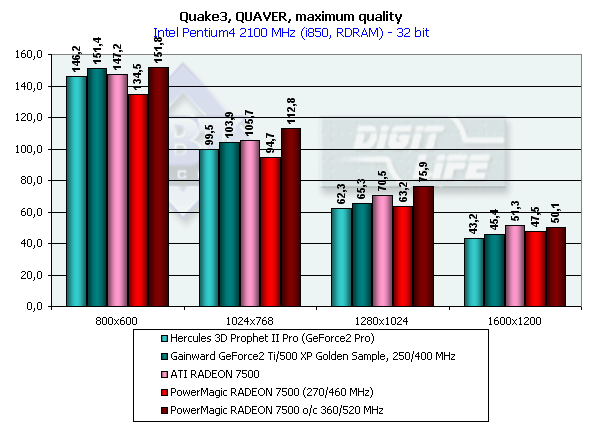 Despite a lower fillrate the RADEON 7500 goes ahead as the GPU's load grows (in 16b-t color). But if the ATI RADEON 7500 outscores the NVIDIA based cards, the PowerMagic RADEON 7500 goes on a par with the latter ones. Bear in mind that the accelerated memory and chip don't help much as it was expected. Giants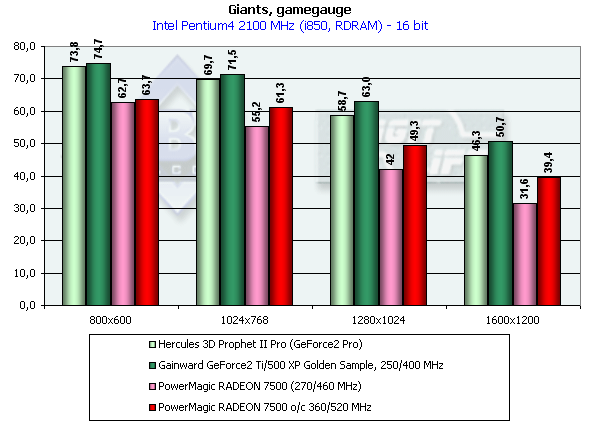 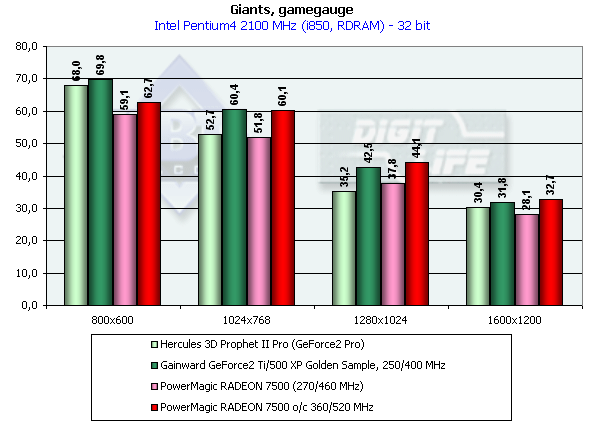 This game is traditionally a heel of Achilles for ATI, but in the Trucolor the PowerColor RADEON 7500 doesn't yield to the GeForce2 Pro. PowerMagic RADEON 8500Quake3 Arenademo002, standardThe tests were carried out in the High Quality mode (32-bit color). 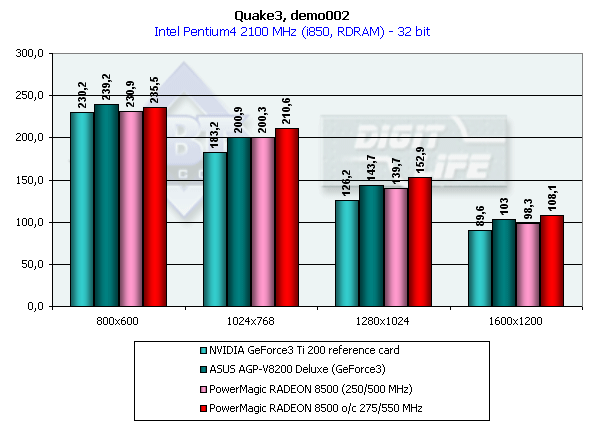 As usual, the RADEON 8500 working at 250/250 MHz easily beats the GeForce3 Ti 200 and falls a bit behind the GeForce3. The overclocked RADEON 8500 (and the ATI's one working at 275/275 MHz) takes a lead. And is there any benefit from the new drivers?: 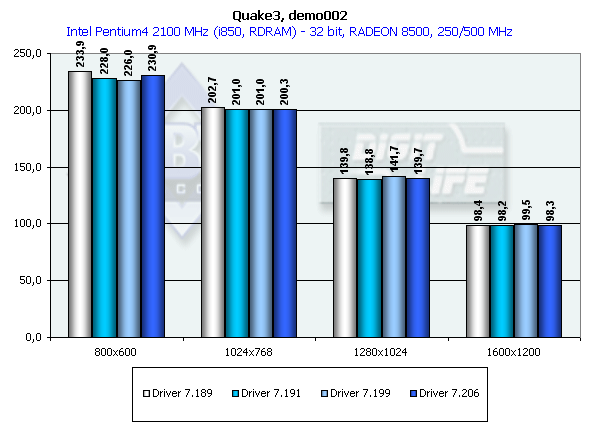 The driver version do not differ as far as the performance in the Quake3 is concerned. quaver, Highest Quality ModeThe tests were carried out in 16 and 32bit color modes with the maximum detailing level of textures and geometry (r_lodCurveError "30000" r_subdivisions "1"). 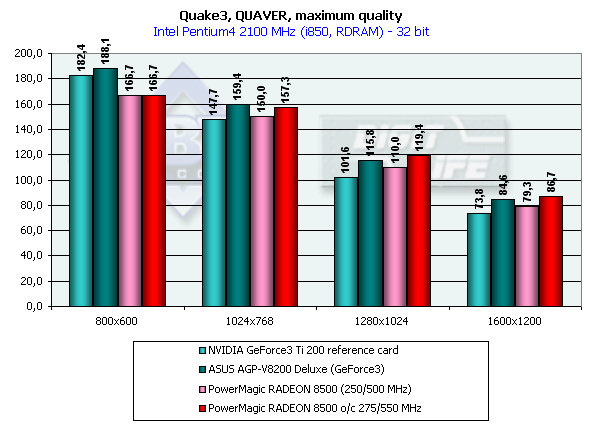 The gap between the PowerMagic RADEON 8500 and the GeForce3 based card is larger, and the RADEON 8500 (250/250 MHz) and GeForce3 Ti 200 perform equally. The PowerMagic overclocked to the level of ATI RADEON 8500 goes on a par with the GeForce3. Why does the RADEON 8500 work worse? Let's look at the performance with different versions of the drivers: 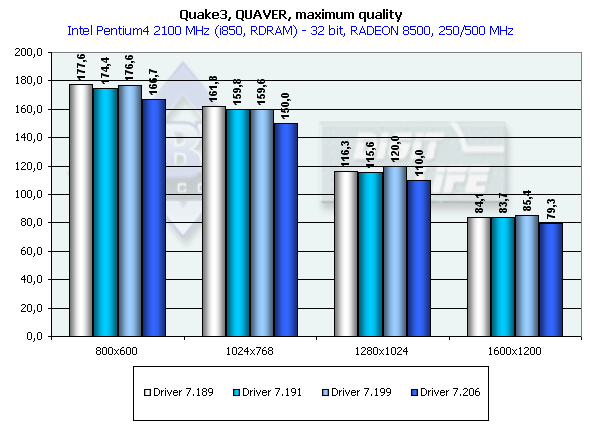 Since ATI removed "optimization" of the drivers for the Quake3 in the high quality mode the performance got poorer. And now we can see the real potential of the RADEON 8500 at the highest quality. I also checked whether the picture will meet the user's requirements established in the Quake3 settings. Look how the RADEON 8500 operates with the previous version of the drivers: NVIDIA GeForce3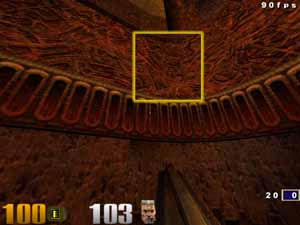 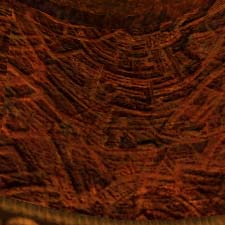 ATI RADEON 8500, driver 7.191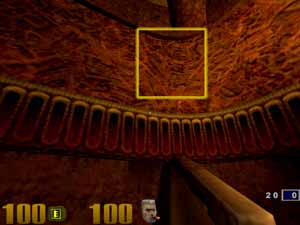 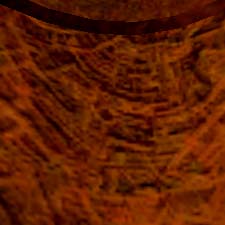 It is clear that the performance of the RADEON 8500 drops. And now ver.7.206: ATI RADEON 8500, driver 7.206 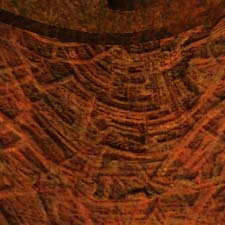 This time the quality and drawing are excellent. Giants
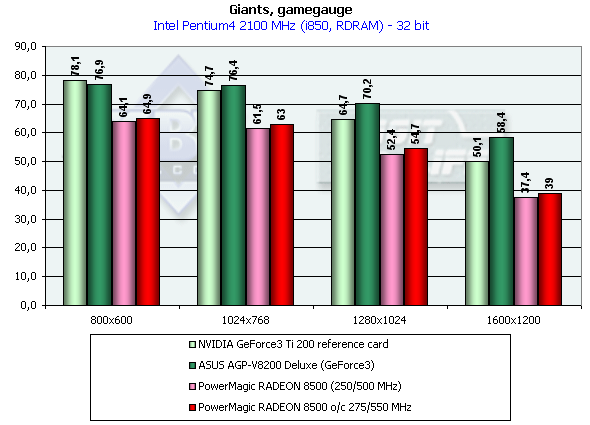 The defeat is obvious. But if you look at our October's 3Digest you will see that the gap is smaller. Now let me test the different driver versions. 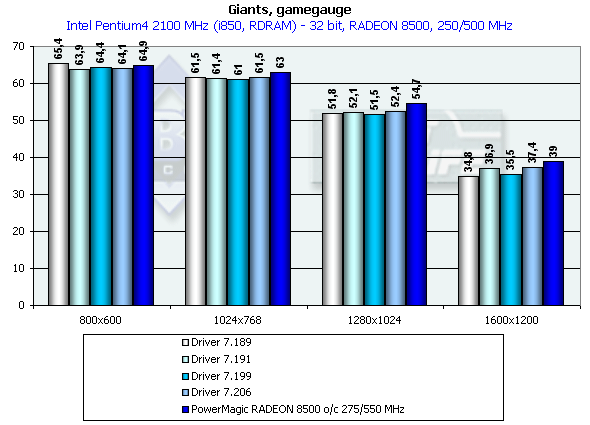 Well, the programmers managed to increase the performance, but the quality still has some drawbacks. 3DMark2001Here we are going to examine the PowerMagic RADEON 8500 overclocked up to the level of the ATI RADEON 8500 - 275/275 MHz, and NVIDIA GeForce3 Ti 500. 3D Marks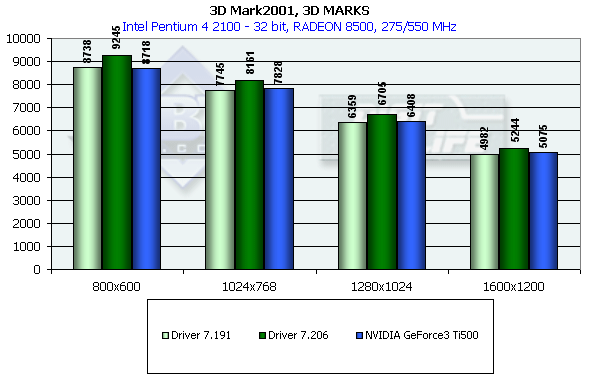 With the new version the ATI's card takes the lead in the end. Game1Game1 Low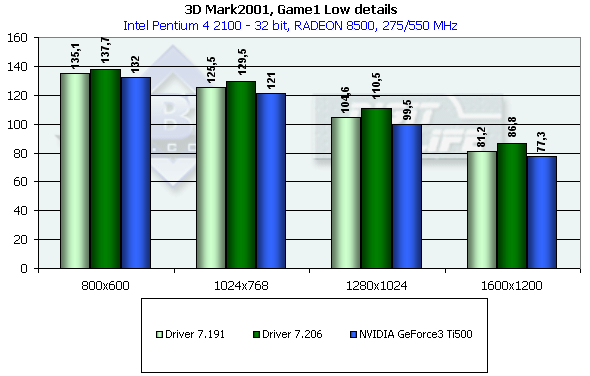 Game1 High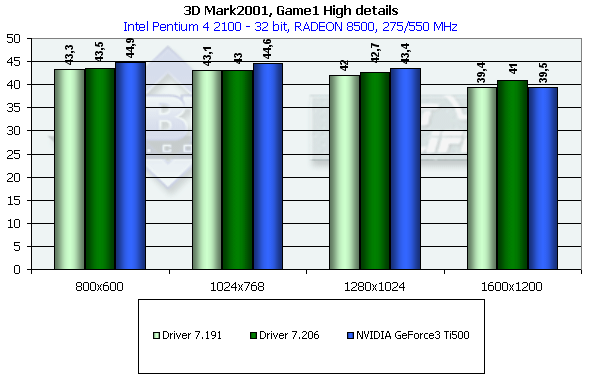 Thanks to the new drivers the ATI's card easily beats the competitor in the Low Details and comes over it with difficulty only in 1600X1200 in the High Details. Game2Game2 Low Game2 High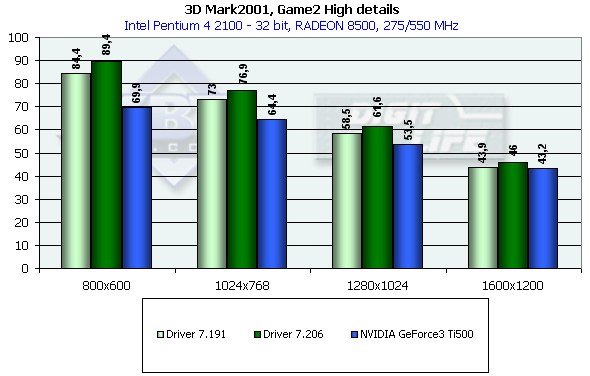 The new driver strengthens the leadership of the RADEON 8500. Game3Game3 Low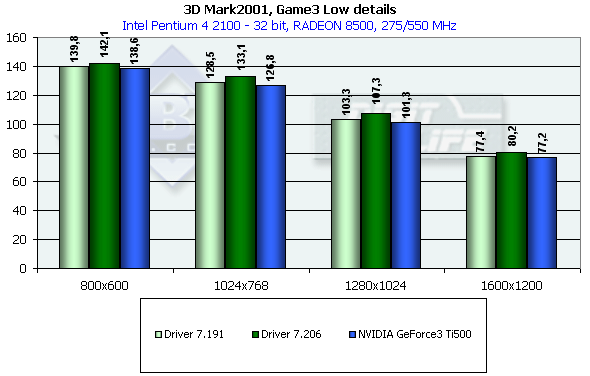 Game3 High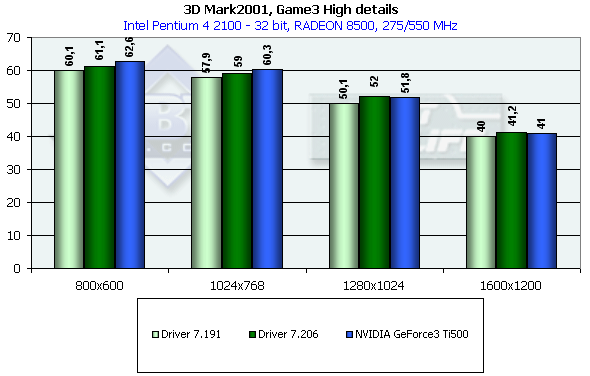 The 7.206 driver let the RADEON 8500 to win from the NVIDIA GeForce3 Ti 500 in the Low Details, and to perform as equals in the High Details. Game4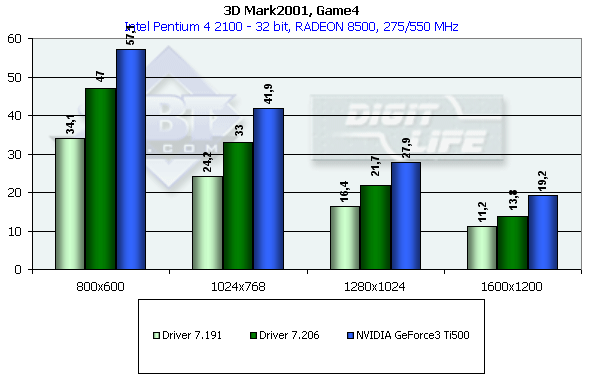 The ATI's pixel shaders work still slower than that of its competitor, though in the new version of the drivers there is some progress. SmoothVisionLet me analyze quality of the adaptive AA. In fact, it is the same FSAA based on the multisampling in D3D and supersampling in OpenGL. The adaptive sampling (when there are more values calculated on the polygon's edge than on the rest of its surface) is not realized yet, and an image is first built in excessive resolution (2X..6X) and then recalculated into the final resolution with averaging according to a certain mask. The mask settings are flexible, and today we have a lot of them - from 2x to 6x, with two variants (performance and quality) for each mask.  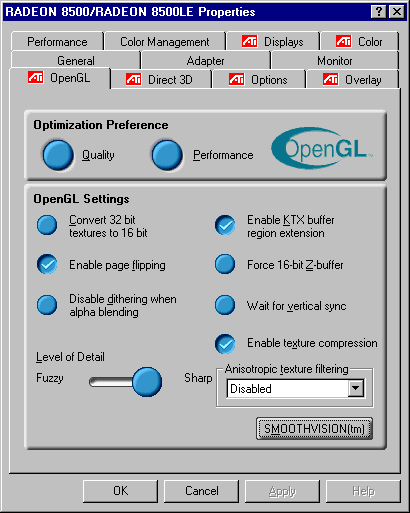 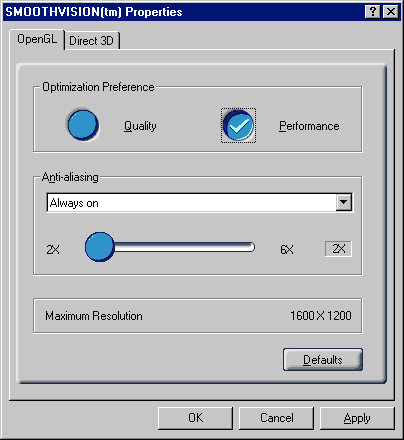 In fact, if you choose "performance" values will be taken from the adjoining AA blocks averaging, and a higher speed will be obtained at the expense of quality. When you choose "quality" this thing doesn't happen , but the accelerator gets a higher load. So: 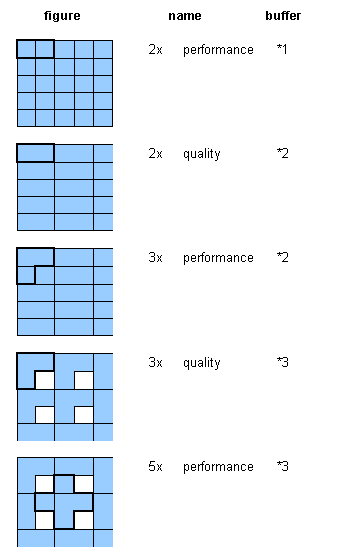 And so on... Calculated source values are in blue, a block which serves for forming a pixel is framed with a thick line, a source multisampling block is framed with a thin one (in OpenGL we have Supersampling). It is possible that 1x2 blocks used in the 2x quality and 3x performance modes are turned at an angle of 45° in the 4x mode (similar to the Quincunx). However that may be, visual quality and speed in the D3D are excellent due to a higher clock speed and, probably, to an efficient realization of flexible FSAA patterns. And now let's look at the performance and quality of the SmoothVision. 3DMark2001Performance: Game1Game1 Low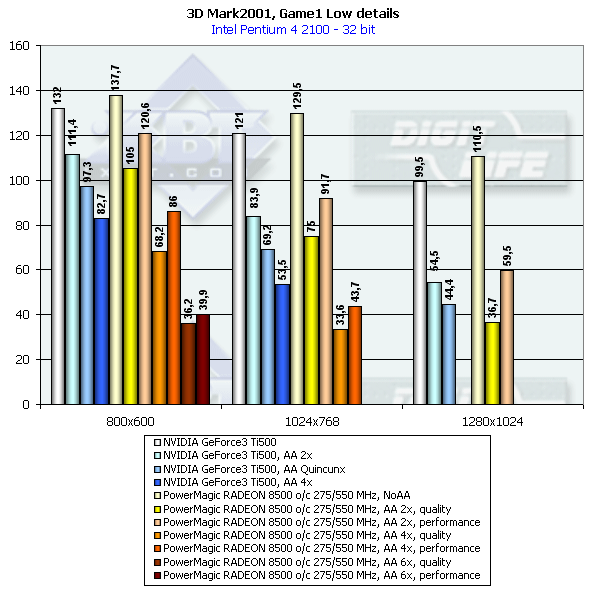 Game1 High Game2Game2 Low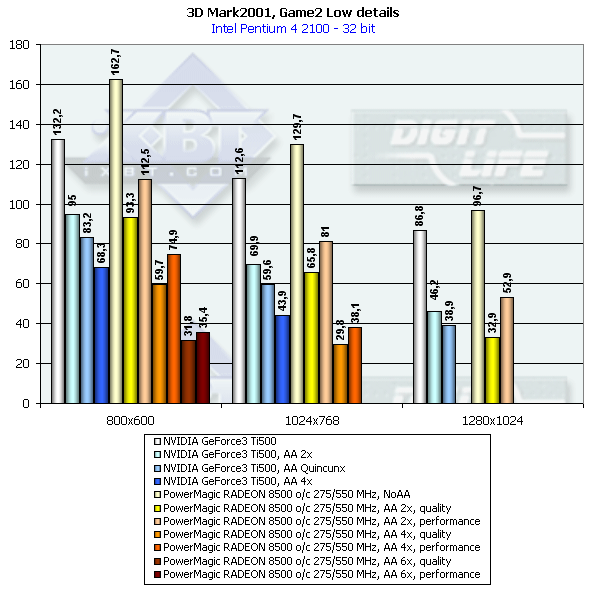 Game2 High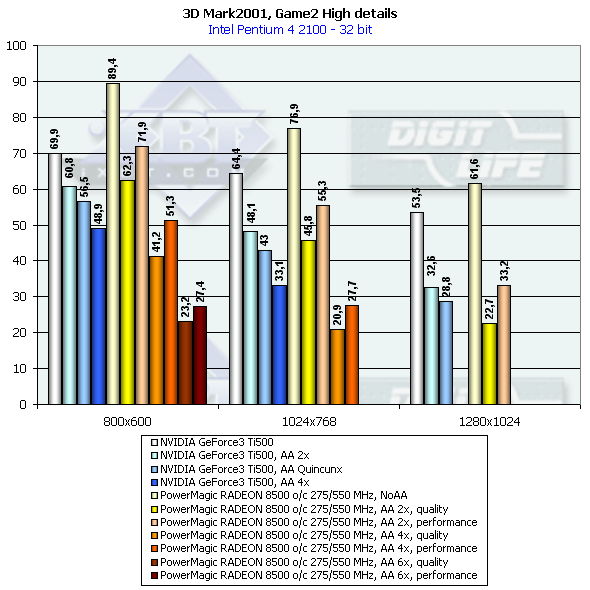 Game3Game3 Low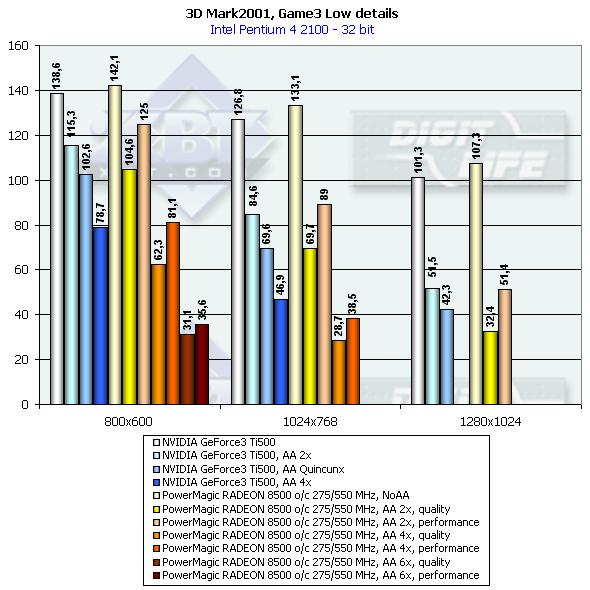 Game3 High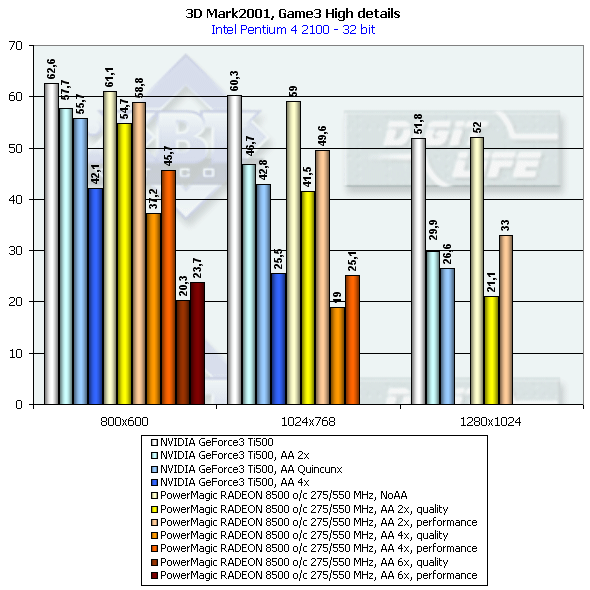 Game4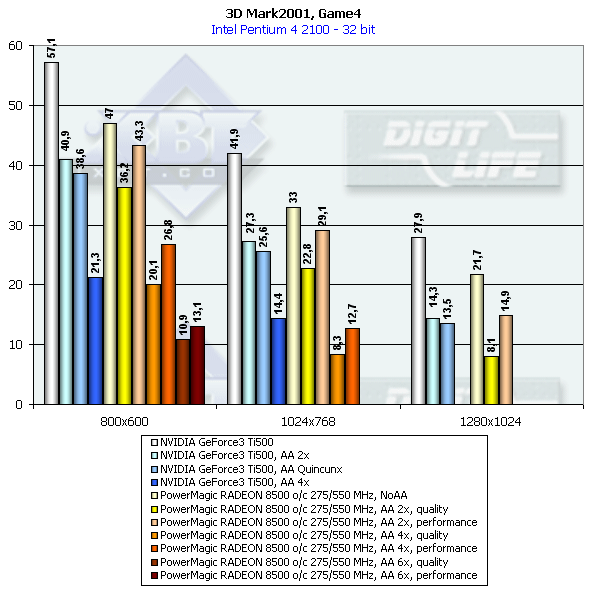 Now let's estimate quality of realization of the AA. First of all, look at the whole scene: 3DMark2001, Game4, No AA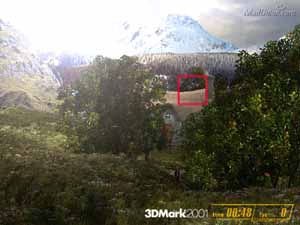 3DMark2001, Game4, AA 2x, quality, performance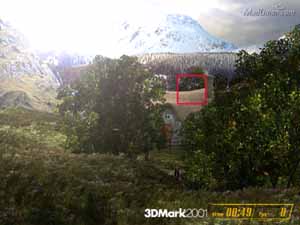 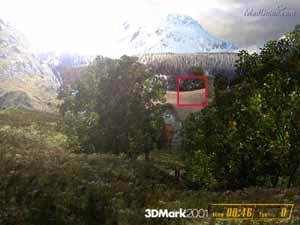 3DMark2001, Game4, AA 3x, quality, performance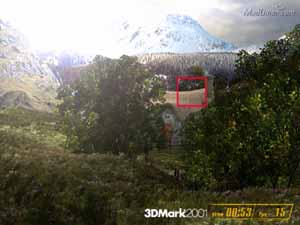 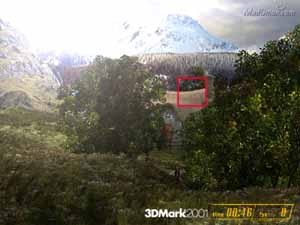 3DMark2001, Game4, AA 4x, quality, performance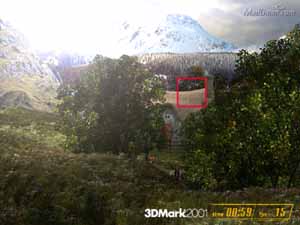 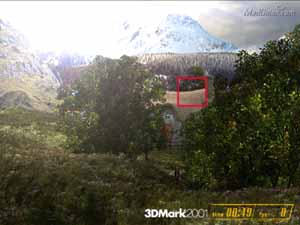 3DMark2001, Game4, AA 5x, quality, performance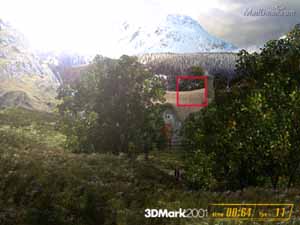 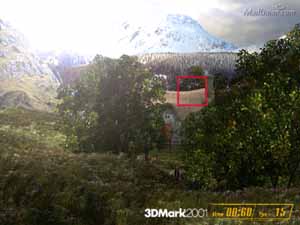 3DMark2001, Game4, AA 6x, quality, performance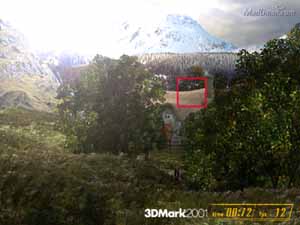 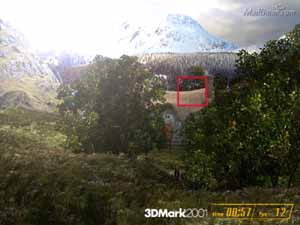 And now take a look at fragments: 3DMark2001, Game4, No AA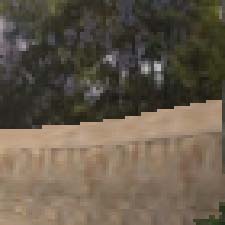 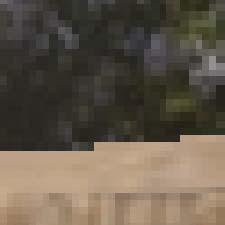 3DMark2001, Game4, AA 2x, quality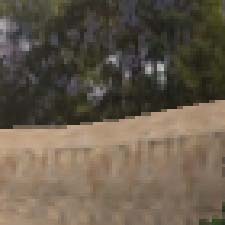 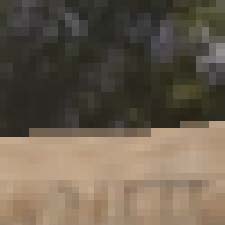 3DMark2001, Game4, AA 2x, performance 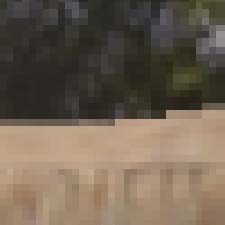 3DMark2001, Game4, AA 3x, quality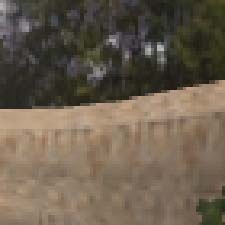 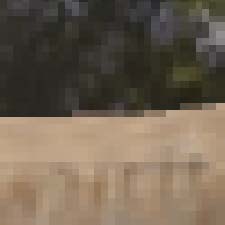 3DMark2001, Game4, AA 3x, performance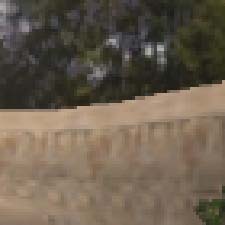 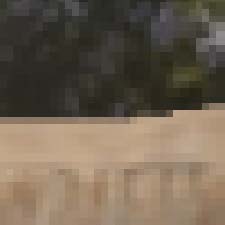 3DMark2001, Game4, AA 4x, quality  3DMark2001, Game4, AA 4x, performance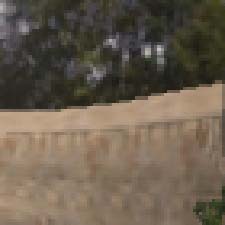 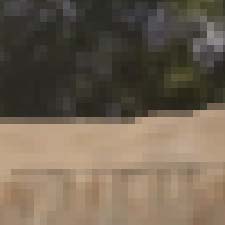 3DMark2001, Game4, AA 5x, quality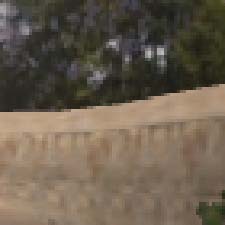 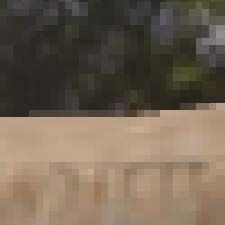 3DMark2001, Game4, AA 5x, performance 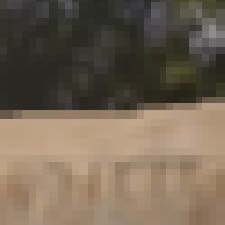 3DMark2001, Game4, AA 6x, quality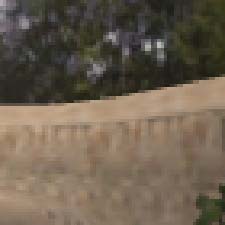 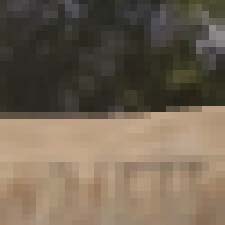 3DMark2001, Game4, AA 6x, performance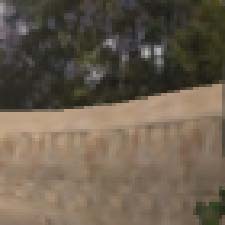 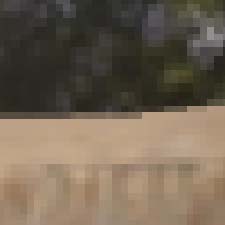 Quake3 ArenaPerformance: 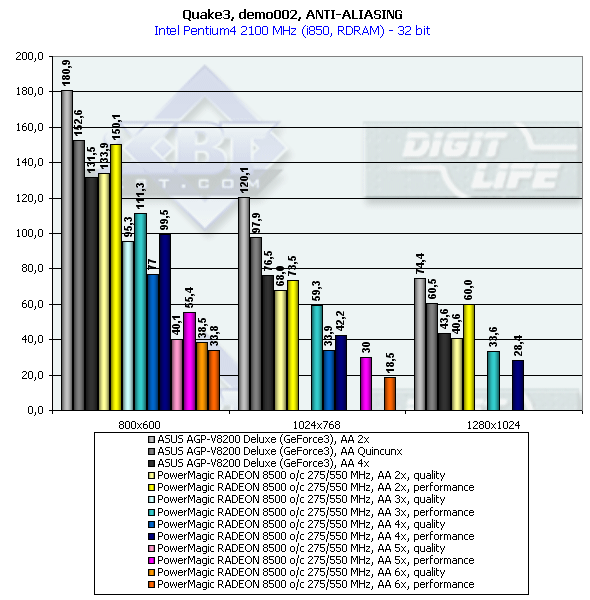 The performance drop is awful (much worse than in the Direct3D). And what about quality? ATI RADEON 8500, No AA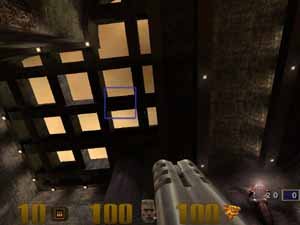 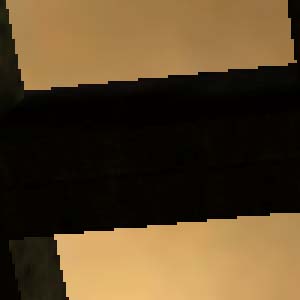 ATI RADEON 8500, AA 2x, quality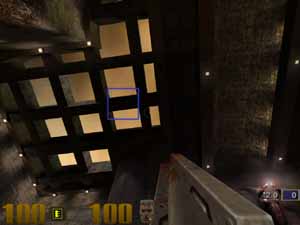 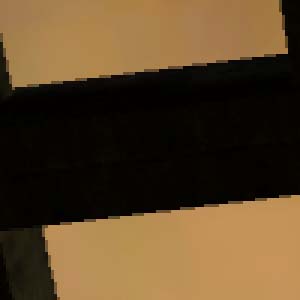 ATI RADEON 8500, AA 2x, performance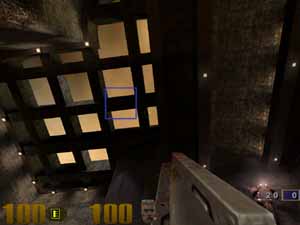  ATI RADEON 8500, AA 4x, quality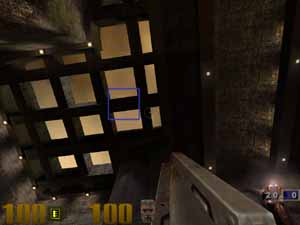 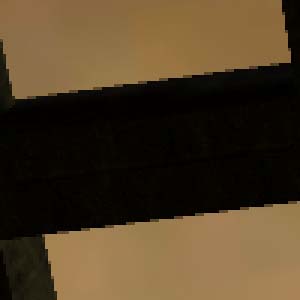 ATI RADEON 8500, AA 4x, performance 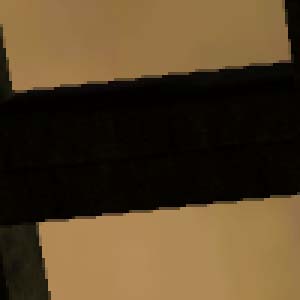 ATI RADEON 8500, AA 6x, quality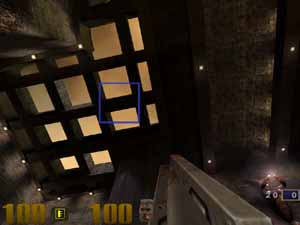 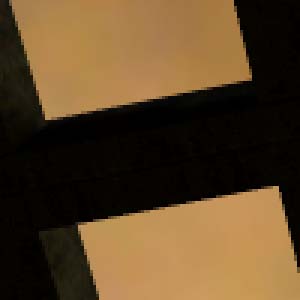 ATI RADEON 8500, AA 6x, performance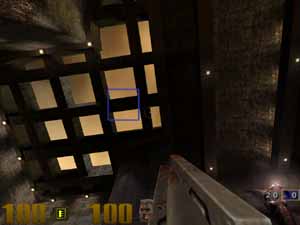 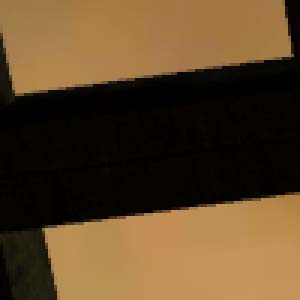 The realization is not that bad, but with such a performance decrease there are not many alternatives in choosing an AA degree and a resolution. And at last, look at the quality of SmoothVision (Max Payne (Direct3D)). NVIDIA GeForce3, No AA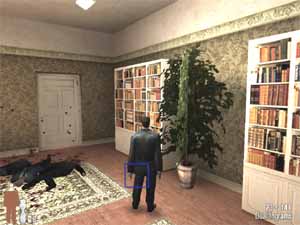 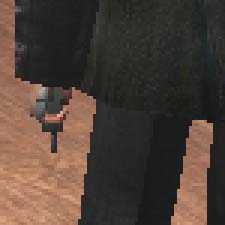 NVIDIA GeForce3, AA 4x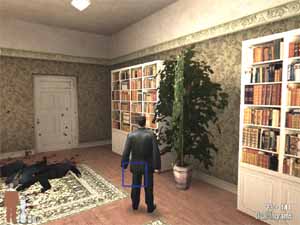 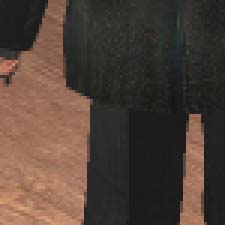 ATI RADEON 8500, AA 2x, quality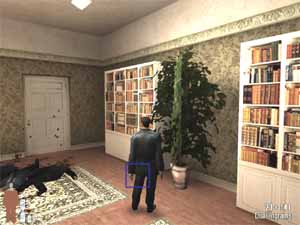 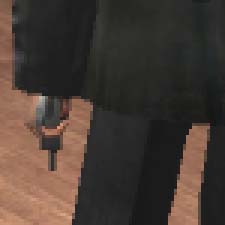 ATI RADEON 8500, AA 4x, quality 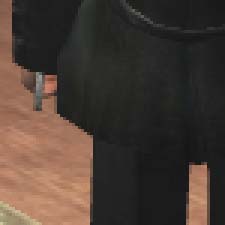 I think the new AA from ATI suits for such games and looks really impressing. 3D qualityWell, despite the increased performance with the new drivers, the quality problems are not yet eliminated. First of all, it is lack of normal trilinear filtering which was found out in the Quake3 (OpenGL): PowerMagic RADEON 7500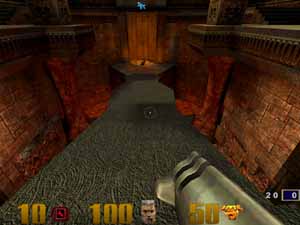 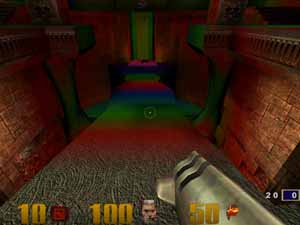 PowerMagic RADEON 8500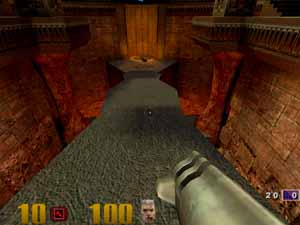 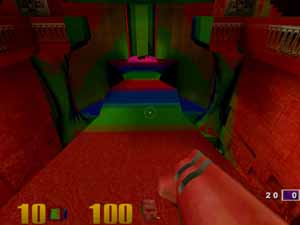 PowerMagic RADEON 8500, Anisotropic filtering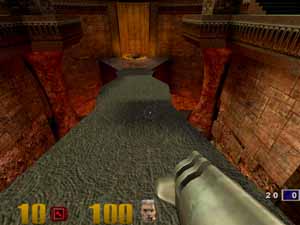 The RADEON 8500 enables the approximation in any driver version (from 7.189 to 7.206), while the RADEON 7500 (and earlier versions) uses the normal trilinear filtering. But in OpenGL an anisotropic filtering will make up for a lack of the trilinear one in the RADEON 8500. In the Direct3D the RADEON 8500 doesn't shine either... In the Giants the trilinear filtering is lacking, and awful artifacts are everywhere: PowerMagic RADEON 8500, driver 7.189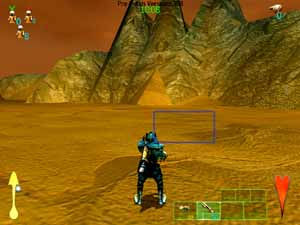  PowerMagic RADEON 8500, driver 7.191 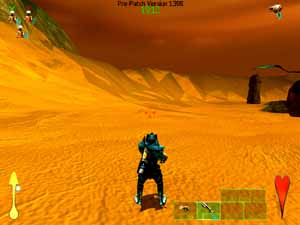 PowerMagic RADEON 7500, driver 7.191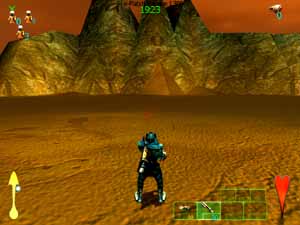  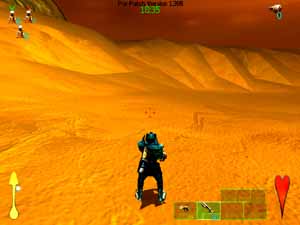 On the upper shot (ver.7.189) I want to show you the sand which is running in front of us in the game where MIP-levels join, - it is well seen "on the run", while you will hardly discern it in a screenshot. These screenshots prove that the trilinear filtering is replaced by approximation. Besides, there are large stripes. Note that the same driver version of the RADEON 7500 and earlier models do not have such shortcomings. A close picture is in the RealMYST: PowerMagic RADEON 8500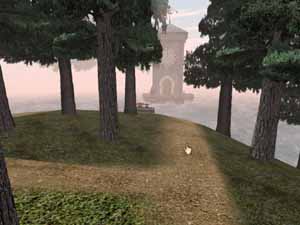 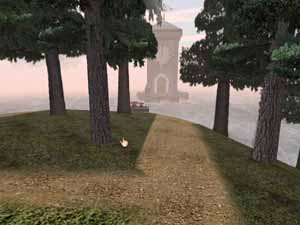  This animated GIF shows how the graphics can change in course of moving. Now look at the Max Payne. Different drivers change greatly the fog when the RADEON 8500 is used: driver 7.189 driver 7.191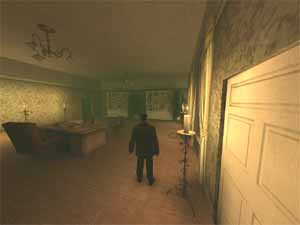 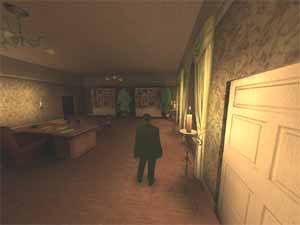 Note that the RADEON/RADEON 7500 card have no problems with both versions of the drivers. The quality is equal to the RADEON 8500 with v7.189 driver. But I should note that the RADEON 7500 did have problems with quality on earlier versions. In closing I recommend you to read our reviews of the ATI RADEON 7500 and 8500. And in our 3Digest you can get information on performance of these cards on different platforms. ConclusionWe have studied two video cards from ATI... or rather from PowerMagic. Bit it doesn't matter as PowerMagic sells the same boards which ship in ATI's boxes with the only difference that the PM cards work at lower frequencies. You should note also that the tests were carried out only under Windows 98/ME.
The complete characteristics of video cards of this and other classes can be found in our 3Digest. Highs:
Lows:
Write a comment below. No registration needed!
|
Platform · Video · Multimedia · Mobile · Other || About us & Privacy policy · Twitter · Facebook Copyright © Byrds Research & Publishing, Ltd., 1997–2011. All rights reserved. |